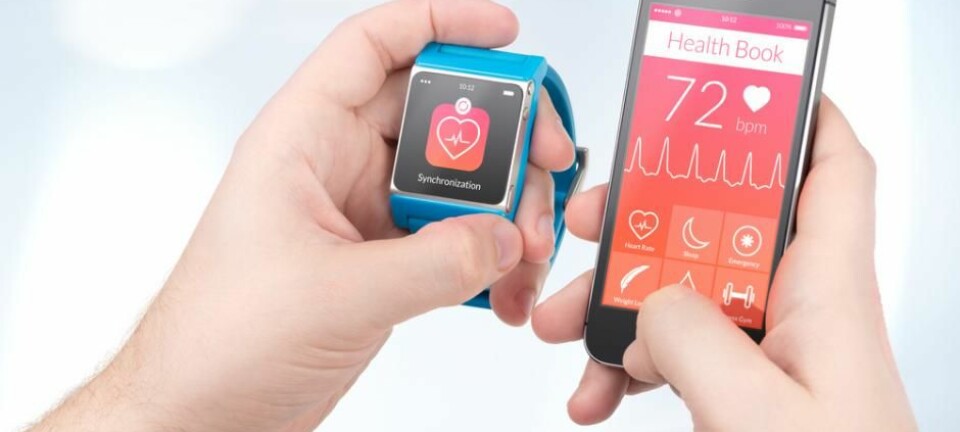
Escape the exercise doldrums with fitness apps
Your smartphone can help you overcome negative mental and physical experiences of exercise.
Exercise is good. And physical activity makes us happy.
It keeps us in shape, protects against lifestyle diseases, and improves body function.
But if you experience a cold shiver every time you head to the gym or think about finding your running shoes, then you could be “exercise challenged.”
This is how I refer to people who fight against negative mental and physical experiences with exercise at some point in their lives.

These people have “the feeling that exercise is always difficult,” as one of my research participants has told me.
In an ongoing research project, I study what happens when the ‘exercise challenged’ use smartphone applications such as Endomondo and Runkeeper to measure, monitor, and reflect over their fitness regime.
The results so far show that the challenges of exercise can be overcome when the smartphone becomes a virtual training partner.
Read More: You are never too old to exercise
Pain is unavoidable with exercise

Exercise challenged people can experience excessive pain when exercising, just like 40-year-old Amanda who began running a few months ago.
“I’m dying, I’m dying,” she proclaims with every step. For Amanda, the experience is so severe that she struggled to even get started.
On one hand, experiencing pain is a good thing—it is a defense mechanism. Imagine if you ran around on a broken foot and your body did not tell you to stop.
On another hand, a certain degree of pain is unavoidable. The body becomes stronger and quicker when we push the functional limits by physical activity. So, it is natural to feel that you are coughing your lungs up or that your body is punishing you in training situations.
Put simply, there is some pain that we should avoid and other types of pain that are necessary to experience if we want to get in shape.
For exercise challenged people like Amanda, who might have a limited experience of exercise, it can be difficult to differentiate between the two.
Read More: We all have to die of something, so why bother being healthy?
Pulse data reduces pain experience
Doctor and philosopher Drew Leder studies the human experience of pain. According to Leder, our experience of pain causes it to change character, meaning that our thoughts can influence the pain we feel.
Amanda often doubts her own pain experience. While running, she asks herself whether the feeling of dying is legitimate or a product of an inexperienced, nervous runner? Does the thought of pain make the pain worse than it actually is? Does an over-thinking mind even induce pain? This is when she turned to Runkeeper.
Activating apps like Runkeeper or Endomondo on your phone means that they start collecting data on how fast you run and how far, and how many calories you burn.
You can view the data on your phone. And if like Amanda you have added a pulse monitor, then you also collect data on your heart beat. Because Amanda mistrusts her own experience of pain she consults her pulse data. She reads and interprets her ‘real’ body condition through the pulse data.
The data gives her an idea of how hard she pushes her body during exercise. When it feels like she is about to die but she sees that her pulse is not especially high, she adjusts down her interpretation of how hard the exercise feels. Thus she actively uses pulse data to reduce her experience of pain while running, making it a more tolerable experience.
Read More: Scientist: lose weight effectively with a simple math-based diet
The gym can be an uncomfortable place
Public health research shows that people who exercise with others have a higher chance of sticking to their training regime. Unfortunately, exercise challenged people have a tendency to avoid gyms and running partners.
Take Dorte as an example. At 29 years old she is overweight and has quit the local gym. She felt that other gym users thought she was a “strange fatty” who was useless at working out.
She felt out of place. It was such an uncomfortable feeling that that she ditched the weights and went home early. One day she stopped going entirely.
Now she exercises in her basement at home. Alone. But Dorte has found a new way to be sociable when exercising: She shares the measurements of her training with a network of Endomondo users.
The network consists of both family and friends. And it functions as “a pair of watchful eyes.” Those eyes mean that Dorte is more likely to exercise and enjoy it.
Read More: Fitness is our religion
Online eyes create a positive pressure
In my study, participants are prompted to stick to their goal of generally being physically active. If they do not exercise, then someone comments either online of offline, for example: “it looks like you’ve been on the lazy side lately)”
And the users try to perform better and appear in the best possible form to other users.
While the direct gaze of gym users was detrimental for Dorte’s motivation, the online eyes created a positive pressure from people who she knew were supportive and wished her well.
For those who do not want to train with other people, online training partners can add a social element that helps maintain their motivation.
Read More: Does it matter how long you sit—if you are fit?
Is it comforting to get ‘wrapped up’ in fitness apps?
Trials have shown that monitoring physical activity can help to make your weekdays easier and even more effective as collecting and analysing piles of data can reveal some undesirable patterns that need to be corrected.
This also applies to those who struggle to exercise. For example, they keep an eye on their weekly training schedule and check whether or not they are on track.
Using apps has other benefits. Fitness apps produced by or in collaboration with professionals from the fitness industry can give users a good feeling while they exercise.
For example, Dorte using fitness videos with aerobic exercises as well as abdominal and back exercises in an app called Workout Trainer. She holds the phone in one hand and follows the instructions on screen. But she simultaneously receives alerts from Endomondo as it monitors her training.
This provides her with control of her training and a running status report of her performance.
Such reports are not always very useful. Some parameters such as distance and average pace can be incorrectly measured and/or irrelevant to the workout if it takes place on the floor or on the spot. But this is not crucial. Simply being monitored can be valuable in and of itself.
A working hypothesis is that users develop a sense of comfort by training along with professional fitness technology: They simply have more control over the situation when they are instructed and tracked by fitness apps, even when the measurements are irrelevant to the type of workout that they are doing.
Read More: How exercise can slow the spread of cancer
A record of training history silences inner critics
Many people simply do not see themselves as exercisers. Critical voices from deep inside tell them that there is no way they can run more than one kilometre.
Signe, 34, has carried those feelings her entire life. She began running a little under one and a half years ago.
Looking through the lens of a psychological theory on narrative identity, people like Signe create and hold on to an identity as an incompetent exerciser. They do so by listening to the negative, internal voices before, during, and after, running.
This is where viewing your training history can help. It acts as an external voice with another narrative: A chronological narrative of exercise activity, irrespective of distance run.
In the app history, Signe can see that she has achieved personal goals to run six, seven, and eight kilometres. She is confronted with a narrative that stands in contrast to her inner voice.
Today, Signe feels like a runner. And in this way, tracking her training routine has helped to change how she sees herself.
Read More: People exercise less when they live next to noisy traffic
Apps can prevent disease?
Digital technology has long been an integrated part of treating diseases, such as monitoring blood sugar levels to keep diabetes in check.
Scientists and product developers are also becoming interested in apps that can prevent disease.
Type-2 diabetes, colon cancer, and heart disease can all be prevented by an active lifestyle.
My project could be used to evaluate how, and to what degree, apps can support the journey from inactive to confident exerciser. And this knowledge could be applied to apps designed to prevent disease.
---------------
Read this article in Danish at ForskerZonen, part of Videnskab.dk
Translated by: Catherine Jex








